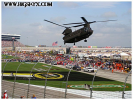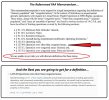14 CFR § 107.25 does indeed say:
That seems explicitly clear, sort of. But it sure seems overly restrictive.
In Canada the equivalent restriction in
CARS 901.37 says:
Here you
can fly from a moving vehicle. You just can't be operating both the drone
and the vehicle at the same time.
You can use a visual observer to keep track of the drone monitoring the airspace, while you focus on flying it. But
CARS 901.20 (4) says the visual observer must then also be focused on his task and not operating the moving vehicle at the same time.
Doesn't that make a lot more sense?
For the moment ignoring all the other stupid aspects of what Ken was doing, technically flying from a carriage being towed by a mule wouldn't have been illegal in Canada as long as Barkley had actually being focused on doing his job of visual observer rather than tasked with holding a camera to record what Ken was doing.
Neither of them was watching the drone! Ken even had to prompt Barkley to take a peek to make sure the drone wasn't being backed into a tree, or flying low enough to be hit by a car. That was all obviously reckless and stupid.
But I'm wondering why the FAA outright restricts flying from any moving vehicle? Flying from a moving motorboat being driven by one person, while you concentrate on flying your drone, with a third person acting as visual observer to keep the drone in sight at all times, isn't illegal in Canada but is prohibited by the FAA.
What exactly is a moving vehicle? What if the boat isn't actually "under way", but is freely drifting with the current or wind? That's "moving", no? What if it's moored or anchored, but swinging at the end of a long mooring line? That's also "moving". What if it's securely tied to a dock, but rocking with some waves? Is that "moving"? Or is all of that perfectly okay as long as your boat is floating in a football field sized area containing less than two other people?
And what's the deal with saying it's then only okay in a sparsely populated area but not if transporting another person's property
for compensation or hire. I thought the whole point of the distinction between the recreational exemptions versus full Part 107 concerned commercial compensation or hire.
So why is there this Part 107 regulation that apparently says you
can fly from a moving vehicle or boat in a sparsely populated area only for fun, but not commercially?? Your FAA regulations make my brain melt.












